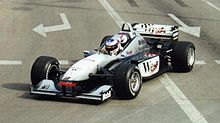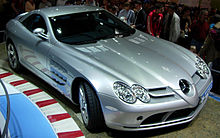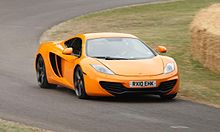- McLaren Automotive
-
McLaren Automotive 
Type Private Industry Automotive Founded 1989 Founder(s) Ron Dennis Headquarters Woking, Surrey, United Kingdom Key people Ron Dennis, (Chairman)
Martin Whitmarsh, (Deputy Chairman)Products Sports cars Employees 1500[1] Website McLarenAutomotive.com McLaren Automotive, commonly referred to as McLaren, is a British automotive manufacturer of high performance vehicles. The company was established as McLaren Cars in 1989 as a producer of road cars based on Formula One technology. It works closely with McLaren Racing, the successful Formula One constructor, and is a spinoff of McLaren Group.
Contents
History
McLaren M81 Mustang
Ford announced the formation of a Special Vehicle Operations (SVO) division headed by Michael Kranefuss in September 1980. SVO's stated purpose was to "develop a series of limited-production performance cars and develop their image through motorsport." Ford introduced the McLaren M81 Mustang in late 1980. The work of designers Todd Gerstenberger and Harry Wykes, it was another heavily modified hatchback with enough built-in potential for easy adaptation to race duty. Looking somewhat like the IMSA show car, the McLaren sported a grille-less nose above a low-riding "skirt" spoiler, plus functional hood scoops, tweaked suspension (mostly a mix of heavy-duty off-the-shelf components), massive fender flares, and premium German BBS alloy wheels wearing broad-shouldered 225/55R15 Firestone HPR radials.
The McLaren Mustang teamed Ford Design with McLaren Performance of Formula One racing fame. Planned production was just 250 examples. Power was again provided by the turbo-four, but it was newly fortified with a variable boost control having a range of 5 psi (0.3 bar)-11 psi (0.8 bar) vs. the regular engine's fixed 5 psi (0.3 bar). Rated output was 175 horsepower (130 kW) at 10 psi (0.7 bar), a big jump over the 132 horsepower (98 kW) stock mill. A $25,000 price tag and virtual hand construction limited McLaren production to just 10 units (including the prototype).[2]
McLaren F1
Main article: McLaren F1The company's first car was the McLaren F1, a supercar that would go 0-60 mph in 3 seconds. Priced at £640,000 (approximately US$1,150,000), it was the world's fastest car for many years, with a top speed of just over 240 mph.[citation needed] The F1 was a three-seat coupe with the driver situated in the middle of the car. The car was designed by Gordon Murray, who also designed competitive formula one racecars for McLaren. The 6,064 cc (370.0 cu in) V12 engine, which produces 627 bhp (468 kW; 636 PS), was designed and built by BMW.
Production of the original F1 began in 1992. The LM model was then introduced in 1995, followed by the GT model in 1997. The GTR was built from 1995 through 1997. Production of the McLaren F1 drew to a close in May 1998, with a total production of 100 cars. Variants produced were 64 F1 (street car), 5 LM, 3 GT, 9 GTR95, 9 GTR96 and 10 GTR97.
The McLaren F1 GTR was developed from the F1 road car, and proved highly effective in the four hour GT races in 1995, its first season of racing. The Le Mans 24 Hours that year was to be McLaren’s first attempt at the world’s most prestigious endurance race.
 McLaren logo from the sill plate of a McLaren F1
McLaren logo from the sill plate of a McLaren F1
McLaren decided to update the 001 chassis–the original test car–and enter it to augment the five customer cars that had been running all season. It was this car, piloted by former Formula One racers JJ Lehto and Yannick Dalmas and experienced Japanese driver Masanori Sekiya that took the chequered flag after a race full of drama. McLaren F1 GTRs finished 1st, 3rd, 4th, 5th and 13th.[citation needed]
The F1 held the record for the fastest production car until 2005, with an independently measured top speed of 242.97 mph (391.02 km/h) at the Volkswagen Ehra-Lessien track in 1998. It has a 0–60 mph (0–97 km/h) time of 3.2 seconds. This has been bettered by the Bugatti Veyron 16.4, and the SSC Ultimate Aero TT. However, the F1 is naturally aspirated while the CCX, Veyron and SSC Aero are not.
Maverick
In 1993, Ron Dennis announced the formation of McLaren Advanced Vehicles (MAV) and an attack on the Land Speed Record with the Maverick supersonic car. Bob Bell was recruited as the technical director for the project.[3] The project was given a budget of £25 million.[4] But after the success of Richard Noble and Andy Green's Thrust SSC, the project was shelved.
McLaren Mercedes MP4/98T
Launched in Australia at the beginning of the 1998 Grand Prix season, the West McLaren Mercedes MP4/98T was the first tandem Formula One car.[5] The unique race car was designed by Gordon Murray to mirror the performance of then contemporary Grand Prix grid and allows a passenger, seated directly behind the driver, to experience the power and exhilaration of a Formula One car. Safety and comfort were fundamental to the design criteria, based on the forces experienced in a Formula One car.
Incorporating many of the F.I.A. driver/passenger safety regulations, the MP4/98T has increased side-impact absorption to safeguard the passenger. Each passenger was seat-fitted using techniques prevalent in Formula One. This specialist foam seating is fitted into the carbon fibre monocoque. A six-point F1 harness seat belt system further ensures the safety of the passenger. A carbon fibre honeycomb composite structure, faced with 75 mm (3.0 in) of conforfoam padding separates the driver and passenger helmet area. Specified according to the F.I.A. impact absorption regulations, this conforfoam design is duplicated on the rear of the headrest structure to protect the passenger in the event of a frontal impact. Together with the head restraint they provide rearward and frontal impact absorption for the driver/passenger configuration. A passenger/driver alert button completes the safety elements.
Numerous celebrities have been passengers in the car, including: Max Mosley, Murray Walker, King Juan Carlos and Erja Häkkinen.
- Year: 1998
- Model Designation: McLaren Mercedes MP4/98T
- Chassis: McLaren carbon fibre monocoque
- Engine: Mercedes-Benz Ilmor FO110G 3.0 litre V10
- Gearbox: McLaren six speed semi-automatic
- Electronics: TAG Electronics
- Wheels: Enkei
- Tyres: Bridgestone
- Dampers: Penske
- Brakes: AP Racing
- Clutch: Sachs
- Fuels & Oils: Mobil 1
- Adhesives: Loctite
- Radios: Kenwood
McLaren SLR (P7 Project)
Main article: Mercedes-Benz SLR McLarenIn 1999, McLaren agreed to design and manufacture the SLR in conjunction with Mercedes-Benz. DaimlerChrysler was the majority shareholder of the McLaren Group as well as engine supplier to the Team McLaren racing team through its Mercedes-Benz division. The final stages of production of the Mercedes-Benz SLR McLaren take place at a unique assembly facility at the McLaren Technology Centre.
The SLR has a 5.5 Litre Supercharged V8 engine that produces 626 bhp (467 kW; 635 PS). It can accelerate from 0–60 mph (0–97 km/h) mph in 3.8 seconds and 0–100 mph (0–160 km/h) in 6.3 seconds.
In 2006, the Mercedes-Benz McLaren SLR 722 Edition was announced. The "722 Edition" creates 650 bhp (480 kW; 660 PS), with a top speed of 340 km/h (6 more than the standard SLR). A new suspension is used with 19-inch (480 mm) light-alloy wheels, a stiffer damper configuration and 0.4 inches (10 mm) lower body.
In 2007, the Mercedes-Benz McLaren SLR Convertible was announced, which has been available from late 2007. The car uses the same supercharged 5.5 litre V8 that is in the coupé.
There is now a limited edition called the SLR Stirling Moss. It is the final SLR to be produced and is a tribute to Sir Stirling Moss. Beneath the scissor-doors is a plaque which has Moss' signature on it.
Aborted projects (P8, P9 and P10)
The partnership between Mercedes-Benz and McLaren resulted in three further cars being proposed. The P9 was to be a mid-engined baby supercar with a less expensive model, the P8 or "SLS", competing with cars such as the Ferrari F430, the Bentley Continental GT and the Aston Martin DB9. Both cars were to be powered by naturally aspirated V-8 engines. The P10 would have been an SLR replacement.
All three cars were aborted in 2005, with Mercedes rumored to have considered the projects simply too costly to turn into a solid business case, although Mercedes' AMG subsidiary is going to produce the SLS alone as the Mercedes-Benz SLS AMG. The car will have a naturally aspirated V8 with over 570 bhp (430 kW; 580 PS). Sales in Europe began from mid-2010.
Upcoming models
McLaren MP4-12C (codename P11)
Main article: McLaren MP4-12CMcLaren Automotive is currently developing a sports car, the MP4-12C, as a successor to the McLaren F1. Rumours were confirmed when Britain's CAR Magazine and icars.sg published the spy shots of the car (then known as P11).[6] The rear wheel drive MP4-12C will be powered by a mid-mounted bespoke McLaren M838T 3.8-litre V8 twin-turbo engine and will have a revolutionary "Carbon MonoCell" carbon fibre chassis. The McLaren MP4-12C also features F1-inspired technology like brake steer, which brakes the inside rear wheel during fast cornering to reduce understeer, and a seven speed Seamless Shift dual clutch gearbox (SSG) with a technology called Pre-Cog. Pre-Cog is the name given to a system whereby the driver can half-pull the paddle shifter behind the steering wheel to get the transmission ready for an upshift, then instantaneous gear change once the paddle is fully pulled. The MP4-12C, whose design was unveiled on 8 September 2009, was launched in 2011 and is aimed at the Ferrari 458 Italia[citation needed] and Lamborghini Gallardo[citation needed] at a price point of £165,000+.[7]
Hypercar (P12)
McLaren may also be developing a new car under the "P12 project", which would cost around £350,000-£400,000. It was first talked of in an issue of the Top Gear Magazine but it has now also been mentioned by Vinnels who admitted that a higher price point "will allow us to play with more exotic materials."[8]
The Baby McLaren (P13)
In issue no. 1,015 of Auto Express Magazine, there was an article about a new McLaren coming out in 2012. It was expected to cost around £80,000, and have a top speed of around 195 mph (314 km/h) and 450 bhp (336 kW; 456 PS). More recent information suggests the project may have been delayed until 2015, and is aimed as a direct competitor to the Porsche 911, suggesting a possible price decrease to around £60,000.[7]
References
- ^ Raynal, Wes (April 19, 2010). "One-on-One with Ron". AutoWeek (Detroit, Michigan: Crain Communications Inc.) 60 (7): 10. ISSN 0192-9674. http://www.autoweek.com/article/20100419/CARNEWS/100419857.
- ^ "HowStuffWorks "Racing the 1980 Ford Mustang"". Auto.howstuffworks.com. http://auto.howstuffworks.com/1979-1980-1981-ford-mustang9.htm. Retrieved 2009-05-29.
- ^ Bob Bell CV - Renault F1[dead link]
- ^ Richard Noble OBE Parliament Speakers.co.uk[dead link]
- ^ McLaren Automotive - News - McLaren Automotive Produces The 1+1 Grand Prix Car: MP4-98t[dead link]
- ^ "New McLaren P11 supercar: the spy photos | Secret New Cars | Car Magazine Online". Carmagazine.co.uk. 2008-10-13. http://www.carmagazine.co.uk/Secret-new-cars/Search-Results/Spyshots/New-McLaren-P11-supercar-the-spy-photos/?content-block=0. Retrieved 2009-05-29.
- ^ a b Dunn, Joseph (2009-09-06). "McLaren MP4-12C: F1’s best bits in a road car". London: Times Online. http://www.timesonline.co.uk/tol/driving/news/article6822585.ece. Retrieved 2010-05-12.
- ^ "Future McLaren Models Will Focus on Efficiency". Insideline.com. 2010-03-18. http://www.insideline.com/mclaren/mp4-12c/future-mclaren-models-will-focus-on-efficiency.html. Retrieved 2010-06-09.
External links
- McLaren Automotive official website
- McLaren Performance Technologies official website
- How It Works magazine article
Engine 1990s 2000s 2010s 0 1 2 3 4 5 6 7 8 9 0 1 2 3 4 5 6 7 8 9 0 1 RMR V12 F1 F1 LM V8 MP4-12C FMR Mercedes SLR Categories:- McLaren Group
- Motor vehicle manufacturers of the United Kingdom
- Sports car manufacturers
- British brands
Wikimedia Foundation. 2010.




